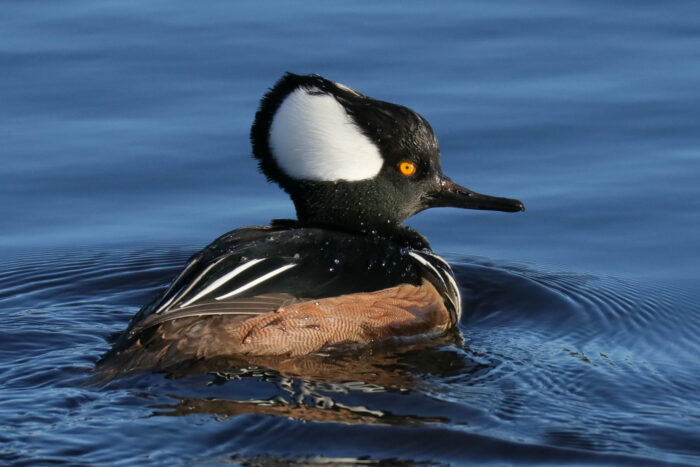Hooded Merganser
Lophodytes cucullatus
The hooded merganser is a diving duck with a distinctive fan-like hood on the back of the head. It lives on freshwater lakes, wooded wetlands and tidal shallows throughout the Chesapeake Bay watershed from autumn through spring.
This section shows one large critter image at a time. Use the thumbnails that follow to select a specific image to display here.

This gallery contains a grid of small thumbnails. Selecting a thumbnail will change the main image in the preceding section.
Appearance
Male and female mergansers have different patterns and coloring. Males are mostly black with rusty brown sides. They have a white, fan-like hood; a white wing patch; small, yellow eyes; and a white breast with two black bars on either side. Females are dark gray or brown with a dusky brown head and chest.
Their hood is cinnamon-colored. Immature males look similar to females. Bills are long and serrated; males have a black bill and females have a brownish bill. The hooded merganser can raise or lower its hood. They grow to 13 to 19 inches with a wingspan of about 26 inches; females are smaller than males.
Feeding
The hooded merganser eats a variety of aquatic creatures, including fish, insects, crabs and crayfish. It usually feeds during the day. It dives underwater to look for and reach its prey, which it captures with its serrated bill. Its extremely muscular gizzard allows it to digest the hard exoskeletons of some shellfish.
Predators
Humans hunt hooded mergansers.
Flight
This duck takes off by running across the water’s surface and flapping its wings. In flight, all mergansers hold their bill, head, body and tail straight. They land on the water by “skiing” across the surface to slow down.
Voice
The merganser's call is a low, croaking grunt.
Reproduction and life cycle
Breeding occurs mostly in Canada and the Midwest. Some hooded mergansers breed locally in parts of Maryland in March and April. They nest in tree cavities or artificial nest boxes near water. Females lay five to 10 glossy, white eggs that hatch in about 33 days. The male abandons the female after she has finished laying her eggs.
If the female is disturbed while incubating her eggs, she will abandon her nest. Females can often lay a new clutch if predators eat her first one. One day after her ducklings hatch, the female leads them out of the nest to the nearest water body. The ducklings are able to dive for food and feed themselves. Ducklings fledge by the time they are 10 weeks old.
Did you know?
- Hooded mergansers are the smallest of the three types of mergansers that live in North America.
- Although they are strong swimmers, hooded mergansers are awkward on land because their legs are located far back on their body.
- They are one of the quickest diving ducks to jump from the water when startled.
- During migration, hooded mergansers prefer to follow waterways.
- The hooded merganser has special transparent eyelids that act like goggles to protect its eyes while looking for prey underwater.
Sources and additional information
- Chesapeake Bay: Nature of the Estuary, A Field Guide by Christopher P. White
- Animal Diversity Web: Lophodytes cucullatus – University of Michigan Museum of Zoology
- Waterfowl ID: Hooded Merganser – Ducks Unlimited
- All About Birds: Hooded Merganser – The Cornell Lab of Ornithology
